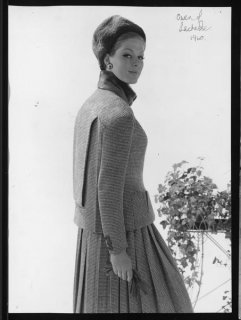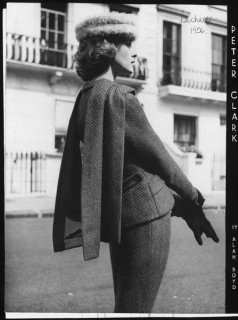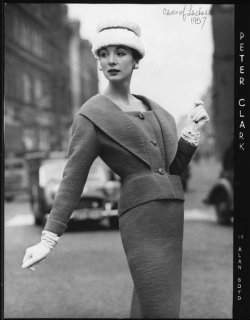from answers.com
The early success of Lachasse owed much to the popularity of sportswear during the 1920s, as advocated by Coco Chanel who also promoted the use of British wools and tweeds for these clothes. Certain other factors played a significant role in establishing Lachasse— Digby Morton presented his first collection there in 1929, the year of the Wall Street Crash, which saw a dramatic fall in the number of American buyers at the Paris couture houses. Many overseas buyers turned to London, attracted by the new generation of couturiers and the lower prices.
According to Peter Lewis-Crown, who joined Lachasse in 1949 and became the couture house's owner, its three main designers, all of whom left their mark, were Digby Morton, who popularized Donegal tweed for womenswear; Hardy Amies, who gave the tailored suit a geometrical approach by using the fabric selvedge around the body instead of downwards, and Michael Donellan, who made the tailored suit an acceptable mode of dress from morning through to evening.
Hardy Amies joined the house of Lachasse after Morton's departure in 1934, learning about the construction of tailored suits by examining copies of Morton's models. Michael Donellan followed Amies to Lachasse where he trained until he established his own house in 1953. Originally a miliner, Donellan was the only designer to have his name on the label, which read "Michael at Lachasse." The Irish-born designer was also likened to Balenciaga because of his strong, uncompromisig signature. In the postwar period Lachasse enjoyed a sizable export trade, particularly with America. The firm used to send a doll called Virginia around the world, dressed in the latest clothing by Lachasse, and took orders for her couture outfits. As a member of the Incorporated Society of London Fashion Designers (ISLFD), the house also partook in the export and publicity ventures organized by the ISLFD.
Lachasse was exclusively a couture house until 1981 when Peter Lewis-Crown opened a mini-boutique on the premises. He was also responsible for introducing more dresses and feminine clothes to the house, once famed principally for its tailored suits. Former attempts to introduce eveningwear had been unsuccessful. Hardy Amies describes Lachasse's La Soirée department as "un-epoch-making" and it was closed down, with many of the evening gowns unsold. While Lachasse can make no claims to breaking any fashion barriers, it is one of the longest-surviving couture houses and continues to attract an international clientéle to its Kensington premises.
- Founded: by Fred Singleton as couture sportswear branch of Gray, Paulette and Singleton, 1928; company incorporated as Lachasse Ltd., 1946.
- Company History: Chief designers include Digby Morton, 1928-33, Hardy Amies, 1934-39, Michael Donellan, 1941-52; Peter Lewis-Crown (born, 1930) joined Lachasse as apprentice, 1948; became director, 1964; later became designer and sole owner; Lachasse has also produced clothes for theatre, film and television productions.
- Collections: Victoria & Albert Museum, London; Costume Gallery, Castle Howard, York; Costume Museum, Bath, England.
- Company Address: 29 Thurloe Place, London SW7 2HQ, England.
The early success of Lachasse owed much to the popularity of sportswear during the 1920s, as advocated by Coco Chanel who also promoted the use of British wools and tweeds for these clothes. Certain other factors played a significant role in establishing Lachasse— Digby Morton presented his first collection there in 1929, the year of the Wall Street Crash, which saw a dramatic fall in the number of American buyers at the Paris couture houses. Many overseas buyers turned to London, attracted by the new generation of couturiers and the lower prices.
According to Peter Lewis-Crown, who joined Lachasse in 1949 and became the couture house's owner, its three main designers, all of whom left their mark, were Digby Morton, who popularized Donegal tweed for womenswear; Hardy Amies, who gave the tailored suit a geometrical approach by using the fabric selvedge around the body instead of downwards, and Michael Donellan, who made the tailored suit an acceptable mode of dress from morning through to evening.
Hardy Amies joined the house of Lachasse after Morton's departure in 1934, learning about the construction of tailored suits by examining copies of Morton's models. Michael Donellan followed Amies to Lachasse where he trained until he established his own house in 1953. Originally a miliner, Donellan was the only designer to have his name on the label, which read "Michael at Lachasse." The Irish-born designer was also likened to Balenciaga because of his strong, uncompromisig signature. In the postwar period Lachasse enjoyed a sizable export trade, particularly with America. The firm used to send a doll called Virginia around the world, dressed in the latest clothing by Lachasse, and took orders for her couture outfits. As a member of the Incorporated Society of London Fashion Designers (ISLFD), the house also partook in the export and publicity ventures organized by the ISLFD.
Lachasse was exclusively a couture house until 1981 when Peter Lewis-Crown opened a mini-boutique on the premises. He was also responsible for introducing more dresses and feminine clothes to the house, once famed principally for its tailored suits. Former attempts to introduce eveningwear had been unsuccessful. Hardy Amies describes Lachasse's La Soirée department as "un-epoch-making" and it was closed down, with many of the evening gowns unsold. While Lachasse can make no claims to breaking any fashion barriers, it is one of the longest-surviving couture houses and continues to attract an international clientéle to its Kensington premises.






